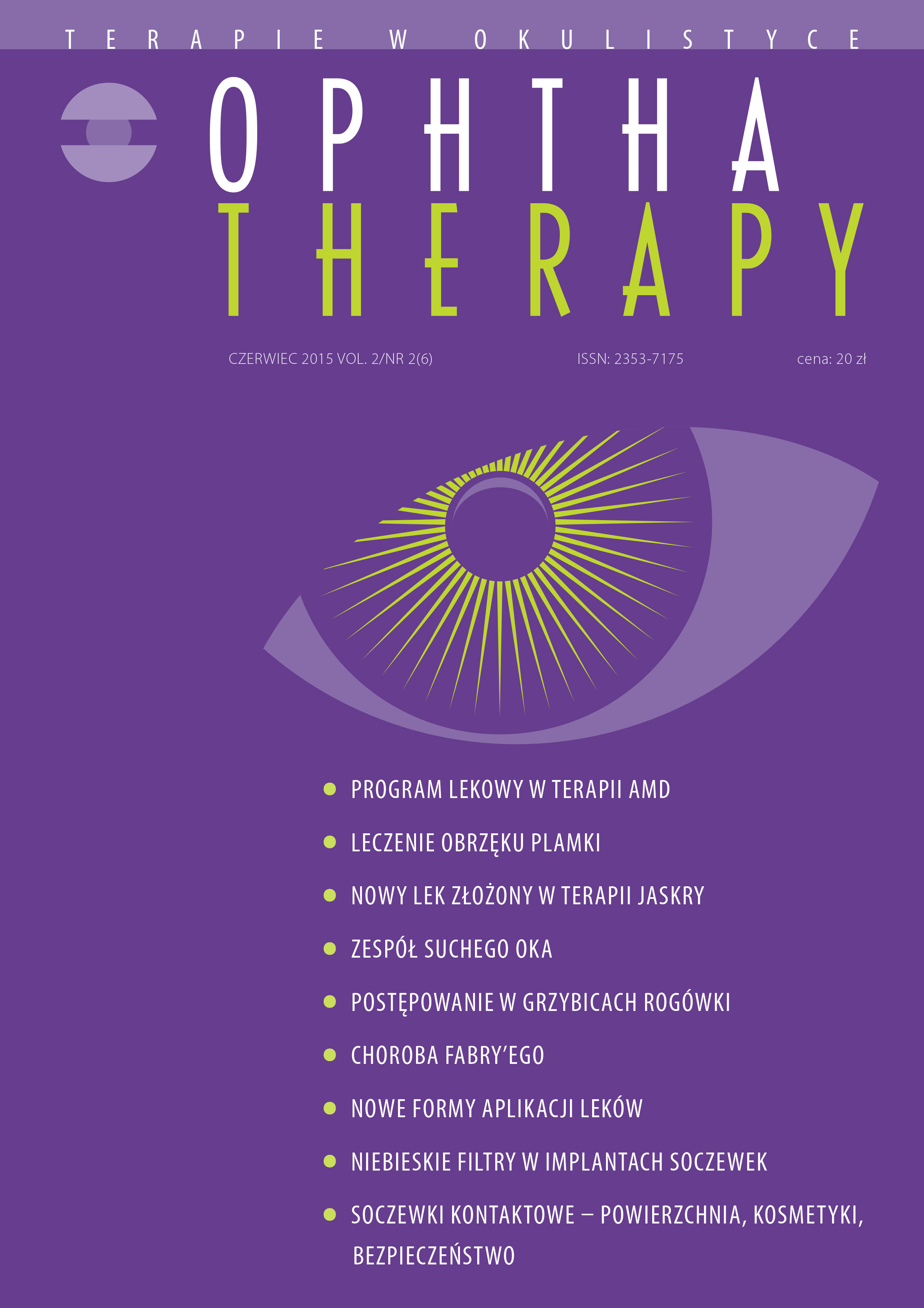Objawy oczne choroby Fabry’ego
##plugins.themes.bootstrap3.article.main##
Abstrakt
Choroba Fabry’ego jest sprzężonym z chromosomem X lizosomalnym schorzeniem spichrzeniowym.
Cel: Celem pracy jest przedstawienie zmian ocznych w przebiegu choroby Fabry’ego.
Materiał i metody: Badaniem objęto 12 chorych w wieku 14–63 lata (średnia wieku 50,2), z czego połowę stanowili mężczyźni. U każdego chorego wykonano pełne badanie okulistyczne.
Wyniki: Stwierdzono prawidłowe ciśnienie wewnątrzgałkowe i ostrość wzroku. Zmiany w naczyniach spojówki miało 4 mężczyzn (66,7%) i 2 kobiety (33,3%). Keratopatia wirowata pojawiła się u 10 chorych (83%): u 5 mężczyzn (83%) i u 5 kobiet (83%). U 4 mężczyzn rozpoznano zaćmę podtorebkową tylną. Typowe zmiany naczyń siatkówki stwierdzono u wszystkich mężczyzn i u połowy badanych kobiet.
Wnioski: Keratopatia wirowata była najczęstszym objawem ocznym choroby Fabry’ego. Bardziej zaawansowane zmiany występowały u mężczyzn.
Pobrania
##plugins.themes.bootstrap3.article.details##

Utwór dostępny jest na licencji Creative Commons Uznanie autorstwa – Użycie niekomercyjne – Bez utworów zależnych 4.0 Międzynarodowe.
Copyright: © Medical Education sp. z o.o. License allowing third parties to copy and redistribute the material in any medium or format and to remix, transform, and build upon the material, provided the original work is properly cited and states its license.
Address reprint requests to: Medical Education, Marcin Kuźma (marcin.kuzma@mededu.pl)
Bibliografia
2. Rodriguez-Mari A, Coll MJ, Chabas A. Molecular analysis in Fabry disease in Spain fifteen novel GLA mutations and identification of a homozygous female. Hum Mutat. 2003; 22: 258.
3. MacDermot KD, Holmes A, Miners AH. Anderson-Fabry disease: Clinical manifestations and impact of disease in a cohort of 98 hemizygous males. J Med Genet. 2001; 38: 750-60.
4. Eng CM, Guffon N, Wilcox WR et al. Safety and efficacy of recombinant human alpha-galactosidase A replacement therapy in Fabry’s disease. N Engl J Med. 2001; 345: 9-16.
5. Bazan-Socha S, Miszalski-Jamka T, Petkow-Dimitrow P et al. Stabilizacja kliniczna choroby Fabry’ego w toku 54-miesięcznej enzymatycznej terapii zastępczej – ciąg dalszy obserwacji. Pol Arch Med Wewn. 2007; 117: 260-5.
6. Mehta A, Beck M, Eyskens F et al. Fabry disease: a review of current management strategies. QJM. 2010; 103: 641-59.
7. Germain DP. Fabry disease. Orphanet J Rare Dis. 2010; 22: 5-30.
8. Nguyen TT, Gin T, Nicholls K et al. Ophthalmological manifestations of Fabry disease: a survey of patients at the Royal Melbourne Fabry disease Treatment Centre. Clin Experiment Ophthalmol. 2005; 33: 164-8.
9. Sodi A, Ioannidis AS, Mehta A et al. Ocular manifestations of Fabry’s disease: data from the Fabry outcome survey. Br J Ophthalmol. 2007; 91: 210-4.
10. Orssaud C, Dufier J, Germain D. Ocular manifestations in Fabry disease: a survey of 32 hemizygous male patients. Ophthalmic Genet. 2003; 24: 129-39.
11. Hirano K, Murata K, Miyagawa A et al. Histopathologic findings of cornea verticillata in a womean heterozygous for Fabry’s disease. Cornea. 2001; 20: 233-6.
12. Wasielica-Poslednik J, Pfeiffer N, Reinke J et al. Confocal laser-scanning microscopy allows differentiation between Fabry disease and amiodarone-induced keratopathy. Graefes Arch Clin Exp Ophthalmol. 2011; 249: 1689-96.
13. Sodi A, Guarducci M, Vauthier L et al. Computer assisted evaluation of retinal vessels tortuosity in Fabry disease. Acta Ophthalmol. 2013; 91: 113-9.

